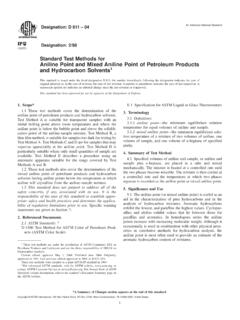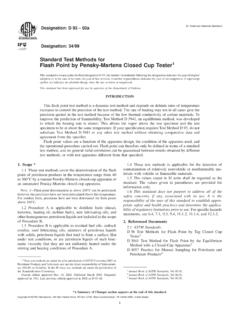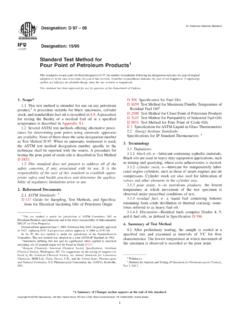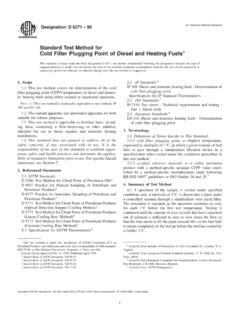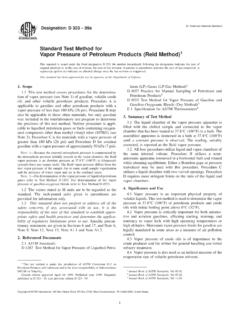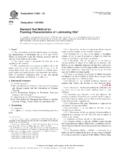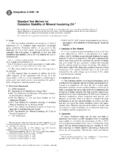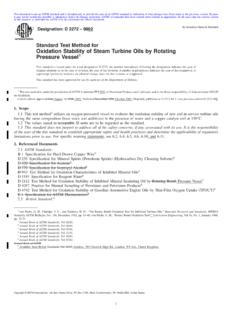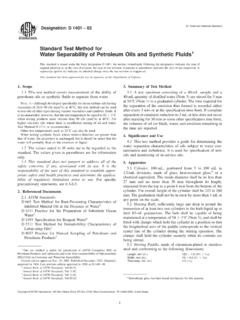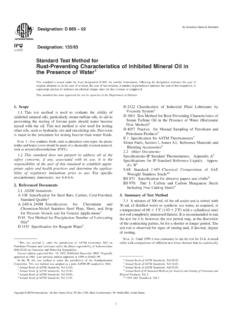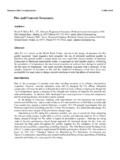Transcription of Standard Test Method for Dropping Point of Lubricating ...
1 Designation: D 2265 00An American National StandardStandard Test Method forDropping Point of Lubricating Grease Over WideTemperature Range1 This Standard is issued under the fixed designation D 2265; the number immediately following the designation indicates the year oforiginal adoption or, in the case of revision, the year of last revision. A number in parentheses indicates the year of last reapproval. Asuperscript epsilon (e) indicates an editorial change since the last revision or Standard has been approved for use by agencies of the Department of This test Method covers the determination of the drop-ping Point of Lubricating Standard does not purport to address all of thesafety concerns, if any, associated with its use. It is theresponsibility of the user of this Standard to establish appro-priate safety and health practices and determine the applica-bility of regulatory limitations prior to Referenced Standards:D 217 Test Methods for Cone Penetration of LubricatingGrease2D 235 Specifications for Mineral Spirits (Petroleum Spirits)Hydrocarbon Dry Cleaning Solvent3D 566 Test Method for Dropping Point of LubricatingGrease2D 3244 Practice for Utilization of Test Data to DetermineConformance with Specifications4E 1 Specification for ASTM Thermometers53.
2 Point ,n a numerical value assigned to agrease composition representing the corrected temperature atwhich the first drop of material falls from the test cup andreaches the bottom of the test In the normal and proper operation ofthis test Method , the observed Dropping Point is corrected byadding to it a value representing one third of the differencebetween the oven block temperature and the observed droppingpoint temperature. This corrected value is recorded as thedropping Point of the grease,n a semi-fluid to solid product ofa thickener in a liquid The dispersion of the thickener forms atwo-phase system and immobilizes the liquid lubricant bysurface tension and other physical forces. Other ingredients arecommonly included to impart special Dropping Point ,n the value noted on thethermometer monitoring the internal temperature of the greasetest cup when the first drop of material falls from the test cupand reaches the bottom of the test ,n in Lubricating grease, a substance com-posed of finely-divided particles dispersed in a liquid to formthe product s Thickeners can be fibers (such as vari-ous metallic soaps) or plates or spheres (such as certainnon-soap thickeners), which are insoluble or, at most, only veryslightly soluble in the liquid lubricant.
3 The general require-ments are that the solid particles be extremely small, uniformlydispersed, and capable of forming a relatively stable, gel-likestructure with the liquid 2174. Summary of Test A grease sample in a grease test cup is supported in atest tube placed in an aluminum block oven at a preset constanttemperature. A sample thermometer is placed in the tube and sopositioned that it measures the temperature in the sample cupwithout coming in contact with the As the temperature increases, at some Point a drop ofmaterial will fall from the cup to the bottom of the test reading on the sample thermometer is recorded to thenearest degree as the observed Dropping Point . At the sametime, the temperature of the aluminum block oven is alsorecorded to the nearest One third the difference between the two values is thecorrection factor which is added to the observed value andrecorded as the Dropping Point of the test Method is under the jurisdiction of ASTM Committee D02 onPetroleum Products and Lubricantsand is the direct responsibility of on Physical Tests, Non edition approved Dec.
4 10, 2000. Published January 2001. Originallypublished as D 2265 64. Last previous edition D 2265 Book of ASTM Standards, Vol Book of ASTM Standards, Vol Book of ASTM Standards, Vol Book of ASTM Standards, Vol ASTM International, 100 Barr Harbor Drive, PO Box C700, West Conshohocken, PA 19428-2959, United Significance and The Dropping Point is useful to assist in identifying thegrease as to type and for establishing and maintaining benchmarks for quality control. The results are to be considered tohave only limited significance with respect to service perfor-mance because Dropping Point is a static Cooperative testing6indicates that, in general, droppingpoints by Test Method D 2265 and Test Method D 566 are inagreement up to 260 C. In cases where results differ, there isno known significance. However, agreement between themanufacturer and purchaser as to test Method used is Point Assembly(Fig.)
5 1) consisting of Cup, chromium-plated brass cup conformingto the dimensions shown inA, Fig. Tube7, thin walled, soft glass test tube with rim,having dimensions shown inB, Fig. Support, glass tubing as shown inC, Fig. , thermometer 3C as prescribed in Speci-fication E 1 and shown inD, Fig. , thermometer clamp as shown inE-1,bushings as shown inE-2 andE-3, bushing support ring asshown inE-4, thermometer depth gage as shown inE-5, ametal rod as shown inE-6, and cup gage as shown inE-7, allof Fig. Block Oven, aluminum block oven of thedesign and dimensions shown in Fig. 2. The block shall beequipped with an integral cartridge-type heater. Control of thecurrent to the heater shall be used to obtain and maintain thedesired oven Block Oven Thermometer, conforming tothermometer 11C in accordance with Specification E The sample presented for analysis should be largeenough to make possible the selection of a representativeportion for testing.
6 Examine for any indication of non-homogeneity such as oil separation, phase changes, or grosscontamination. If any abnormal conditions are found, obtain anew data are available from ASTM. Request ExAx No. 45050, 13 by 100-mm tubes available from mostlaboratory supply houses are satisfactory.(a) Dimensions in 1 Apparatus for Dropping Point Test of Lubricating GreaseD2265 0028. Preparation of Thoroughly clean the cup, cup support, and test tubewith mineral spirits conforming to Specification D 235.(Warning Flammable. Vapor harmful.) Use only cups that are clean and free of any the interior plating of the cup shows indications of wear, When new cups are to be used, check their dimensionsby using the cup plug gage (E-7 of Fig. 1). To check the bottomopening of the cup a mm rod should fit easily while a rod should the hole is undersize, ream to thecorrect size.
7 If too large, discard. Cups of the proper dimen-sions need not be rechecked before each test Test tubes shall be clean and free of residues andconform to the dimensions shown in B, Fig. 1. Inspect for chipsor cracks and replace when Sample thermometer bulb shall be clean and free ofresidues. Inspect bushings for cleanliness and be certain thethermometer clamp,E-1, Fig. 1, is sufficiently tight to hold thethermometer in The glass sleeve used to support the cup shall be free ofany cracks or chips, residue or stain, and conform to thedimensions shown in C, Fig. 1. Replace when Insert empty test tubes in every test tube well and athermometer having a range from 5 to 400 C in the ther-mometer well of the Turn on the oven and select the lowest aluminum blockoven temperature setting from the four listed below that willresult in an observed Dropping Point at or below the corre-sponding maximum observed Dropping Point shown for thatoven temperature Temperature, CMaximum Observed Drop-ping Point , Select and use test tubes and accessoriesE-1,E-2, andE-3 to minimize wobble of the thermometer.
8 All componentsmust be at room temperature prior to the test. Place thecomponentsE-1 throughE-4 on the thermometer in the ordershown by the thermometer assembly (F) Fig. 1. Adjust thebushingE-3 and the bushing support ringE-4 so thatE-4 isabout 25 mm from the tip of the thermometer. Place the cupsupportCin tubeB. Insert the thermometer depth gageE-5 andthe thermometer assembly in the tube. Position the thermom-eter so that the tip bottoms in the gage. Adjust the bushingE-2and the thermometer clampE-1 so that the bushing shoulderson the top edge of the Fill the grease cup by pressing the larger opening intothe grease to be tested until the cup is filled. Remove excessgrease flush with the top edge of the cup with a spatula. Gentlypress the cup, held in a vertical position with the smalleropening at the bottom, down over the metal rodE-6, Fig.
9 1,until the latter protrudes about 25 mm. Press the rod against thecup in such a manner that the rod makes contact at both theupper and lower peripheries of the cup. Maintain this contact,rotating the cup on the rod along the index finger to give it aspiral-like motion down the rod to remove a conical section ofthe grease which adheres along the rod. As the cup approaches8 These are commonly available as a7 64-in. drill and a No. 34 drill 2 Aluminum Block OvenD2265 003the end of the rod, carefully slip the rod out of the cup so thata smooth film of reproducible thickness remains inside the Fig. Remove the thermometer assembly and depth gage fromthe tube. Place the grease cup on the cup support in the testtube and carefully reinsert the thermometer assembly. Make nofurther adjustment as the thermometer bulb is now positionedto provide adequate clearance between the tip of the bulb andgrease sample in the After making certain that the oven temperature hasstabilized, remove an empty tube from the oven and gentlyinsert the tube assembly,G, (Fig.)
10 1) in its place. Exercise careto ensure that the cup remains upright in the cup support. If thecup is tilted, the thermometer bulb can come in contact with thefilm of grease and result in an erroneous When the first drop of material falls free of the cuporifice and reaches the bottom of the test tube, record both thetemperature of the cup and of the oven to the nearest greases, for example, some simple soap compositions,or those containing some types of polymers can form a dropwith a tailing thread which can hold until the drop reaches thebottom of the test tube. The temperature in the cup when thedrop reaches the bottom of the test tube is recorded as theobserved Dropping The aluminum block oven can accommodate up to sixsamples of the same or different greases so that multiple determinationscan be made Calculate the Dropping Point as follows:DP5 ODP1@~BT2 ODP!
